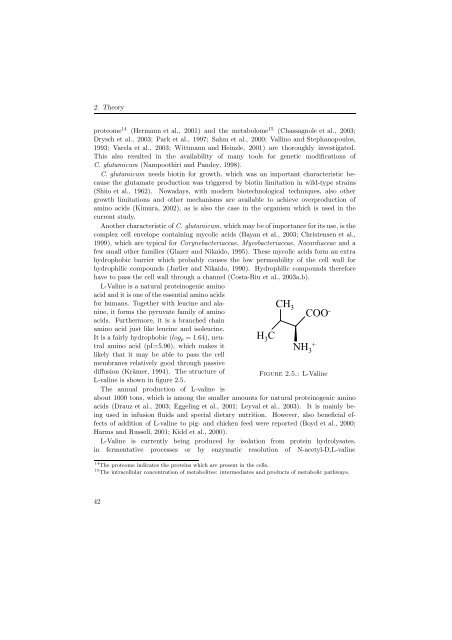Corynebacterium glutamicum - JUWEL - Forschungszentrum Jülich
Corynebacterium glutamicum - JUWEL - Forschungszentrum Jülich
Corynebacterium glutamicum - JUWEL - Forschungszentrum Jülich
You also want an ePaper? Increase the reach of your titles
YUMPU automatically turns print PDFs into web optimized ePapers that Google loves.
2. Theory<br />
proteome14 (Hermann et al., 2001) and the metabolome15 (Chassagnole et al., 2003;<br />
Drysch et al., 2003; Park et al., 1997; Sahm et al., 2000; Vallino and Stephanopoulos,<br />
1993; Varela et al., 2003; Wittmann and Heinzle, 2001) are thoroughly investigated.<br />
This also resulted in the availability of many tools for genetic modifications of<br />
C. <strong>glutamicum</strong> (Nampoothiri and Pandey, 1998).<br />
C. <strong>glutamicum</strong> needs biotin for growth, which was an important characteristic because<br />
the glutamate production was triggered by biotin limitation in wild-type strains<br />
(Shiio et al., 1962). Nowadays, with modern biotechnological techniques, also other<br />
growth limitations and other mechanisms are available to achieve overproduction of<br />
amino acids (Kimura, 2002), as is also the case in the organism which is used in the<br />
current study.<br />
Another characteristic of C. <strong>glutamicum</strong>, which may be of importance for its use, is the<br />
complex cell envelope containing mycolic acids (Bayan et al., 2003; Christensen et al.,<br />
1999), which are typical for Corynebacteriaceae, Mycobacteriaceae, Nocardiaceae and a<br />
few small other families (Glazer and Nikaido, 1995). These mycolic acids form an extra<br />
hydrophobic barrier which probably causes the low permeability of the cell wall for<br />
hydrophilic compounds (Jarlier and Nikaido, 1990). Hydrophilic compounds therefore<br />
have to pass the cell wall through a channel (Costa-Riu et al., 2003a,b).<br />
CH3 COO<br />
H3C -<br />
L-Valine is a natural proteinogenic amino<br />
acid and it is one of the essential amino acids<br />
for humans. Together with leucine and alanine,<br />
it forms the pyruvate family of amino<br />
acids. Furthermore, it is a branched chain<br />
amino acid just like leucine and isoleucine.<br />
It is a fairly hydrophobic (logp =1.64), neutral<br />
amino acid (pI=5.96), which makes it<br />
NH +<br />
3<br />
likely that it may be able to pass the cell<br />
membranes relatively good through passive<br />
diffusion (Krämer, 1994). The structure of<br />
Figure 2.5.: L-Valine<br />
L-valine is shown in figure 2.5.<br />
The annual production of L-valine is<br />
about 1000 tons, which is among the smaller amounts for natural proteinogenic amino<br />
acids (Drauz et al., 2003; Eggeling et al., 2001; Leyval et al., 2003). It is mainly being<br />
used in infusion fluids and special dietary nutrition. However, also beneficial effects<br />
of addition of L-valine to pig- and chicken feed were reported (Boyd et al., 2000;<br />
Harms and Russell, 2001; Kidd et al., 2000).<br />
L-Valine is currently being produced by isolation from protein hydrolysates,<br />
in fermentative processes or by enzymatic resolution of N-acetyl-D,L-valine<br />
14 The proteome indicates the proteins which are present in the cells.<br />
15 The intracellular concentration of metabolites: intermediates and products of metabolic pathways.<br />
42

















